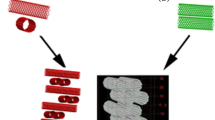Abstract:
We demonstrate the usefulness of two-dimensional hyperbolic geometry as a tool to generate three-dimensional Euclidean (E3) networks. The technique involves projection of edges of tilings of the hyperbolic plane (H2) onto three-periodic minimal surfaces, embedded in E3. Given the extraordinary wealth of symmetries commensurate with H2, we can generate networks in E3 that are difficult to construct otherwise. In particular, we form four-, five- and seven-connected (E3) nets containing three- and five-rings, viz. (3, 7), (5, 4) and (5, 5) tilings in H2.
Similar content being viewed by others
Author information
Authors and Affiliations
Additional information
Received 14 January 2002 / Received in final form 12 August 2002 Published online 4 February 2003
RID="a"
ID="a"e-mail: stephen.hyde@anu.edu.au
Rights and permissions
About this article
Cite this article
Hyde, S., Ramsden, S. Some novel three-dimensional Euclidean crystalline networks derived from two-dimensional hyperbolic tilings. Eur. Phys. J. B 31, 273–284 (2003). https://doi.org/10.1140/epjb/e2003-00032-8
Issue Date:
DOI: https://doi.org/10.1140/epjb/e2003-00032-8




